Get PeakVisor App
Sign In
Search by GPS coordinates
- Latitude
- ° ' ''
- Longitude
- ° ' ''
- Units of Length
- Temperature

Yes
Cancel
Share ×

Scan the QR code and open PeakVisor on your phone
❤ Wishlist ×
Choose
Delete
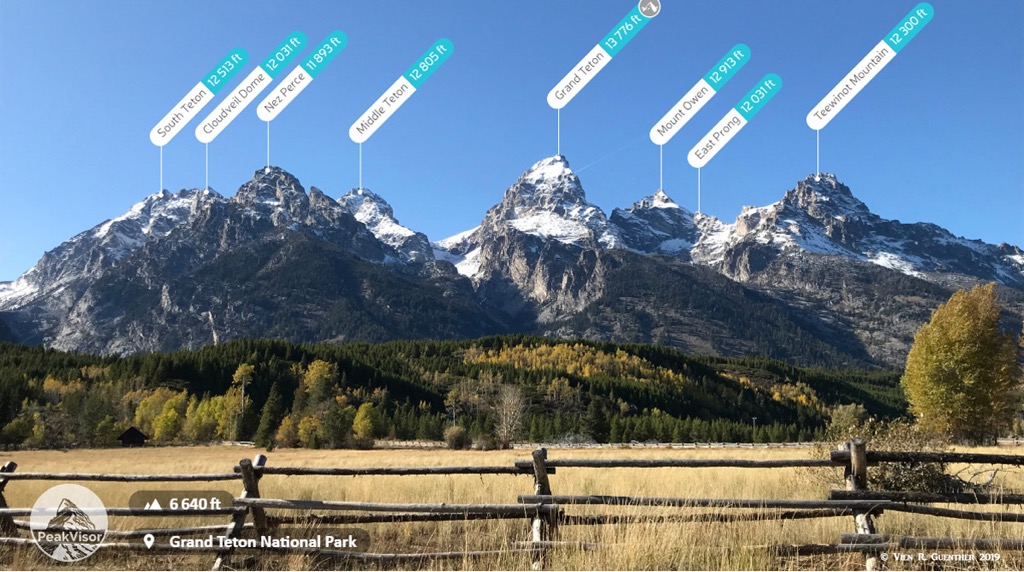
Jackson Hole Mountain Resort (JHMR) is the biggest ski resort in Wyoming and one of more than 500 in the US with over 130 slopes of 72 mi (116 km) in total, which are best suited for intermediate and advanced skiing, and 13 ski lifts. The resort boasts the largest vertical drop in the US of 4,139 ft (1,261 m). However, its main feature is not the size, the lift infrastructure, or inbounds skiable acreage, but the sheer amount of steep, off-piste skiing accessible from the lifts in the legendary Teton Range. At a reported 450 in (11.43 m) a year, the mountain receives copious amounts of snowfall and features a long season lasting from late November to early April.
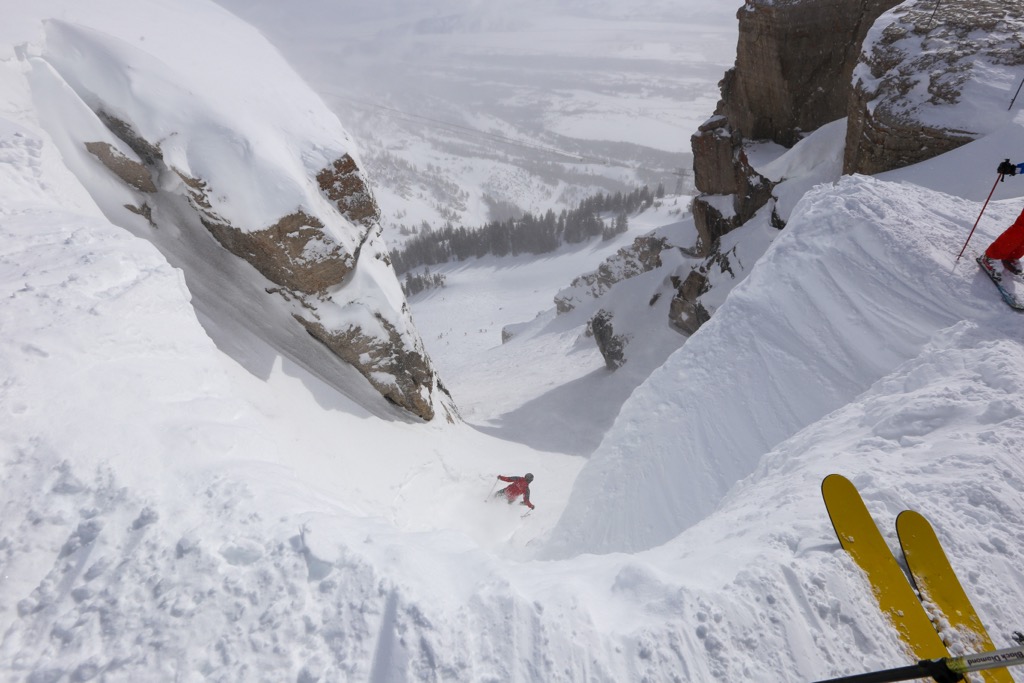
The Jackson Hole ski area is the centerpiece of Jackson, a charming and chic town in Teton County in the northwestern portion of Wyoming.
Geographically, JHMR occupies the central-eastern flanks of the iconic Teton Range, a subrange of the larger Western Rocky Mountains. The Tetons are massive peaks and stretch 40 mi (54.3 km) from north to south but only 12 mi (19.2 km) from east to west.
The “Hole” in the name of the resort refers to the deep valley encompassing 55 sq mi (142 sq km) of pristine habitat surrounded by towering mountains. The vertical relief found in this valley is some of the greatest in Western North America. The town of Jackson sits at 6,237 ft (1,901 m), while the Grand Teton reaches 13,775 ft (4,198 m).
The aerial tramway, Jackson’s signature lift, reaches the summit of Rendezvous Mountain and the crest of the Teton Range range (10,449 ft / 3,814 m) from 6,311 ft (1,923 m) at Teton Village; a vertical drop of 4,139 ft (1,261 m).
Many visitors are eager to know whether they can see the so-called “Cathedral Group” of the Tetons. The name refers to the majestic high peaks of the north-central portion of the range, including Mount Owen (12,881 ft / 3,926 m) and three Teton peaks: Grand Teton (13,1776 ft / 4,198 m), Middle Teton (12,805 ft / 3,902 m), and South Teton (12,513 ft / 3,813 m). While JHMR is just a few canyons to the south of these high peaks — hardly a couple of miles as the crow flies — they aren’t as striking from the south as they are from the east.
The most iconic image of Jackson is an old T. A. Moulton Barn with the Tetons as a backdrop, but that’s not what you’ll see from the resort. Instead, you get an incredible panorama of Jackson Hole and the mountains beyond. Fortunately, skiing will quickly become the focus upon your arrival.
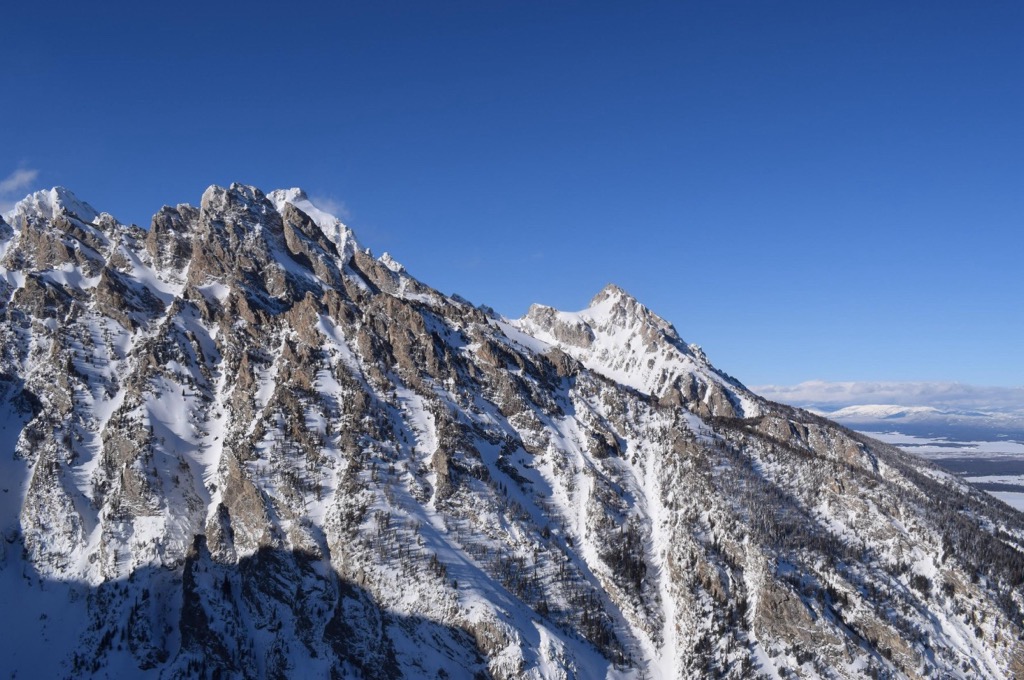
Jackson Hole is relatively simple and easy to get to in three main ways: by plane and public transportation, or car:
Despite its population of only 10,700, Jackson is an important economic hub and hosts the busiest commercial airport in Wyoming, Jackson Hole Airport (JAC). It’s easy to find flights to Jackson — there are non-stop options from 13 cities across the US, including every region of the country. There are also more distant airports:
Once you’ve arrived at the airport, it’s only 10–20 minutes to town and 30 minutes to Teton Village. Many hotels and other types of lodging provide complimentary shuttles from the airport.
If you’re not staying in Teton Village, the primary option for transportation to the resort is to take the START Bus. It is great. It stops in all the best places, is easy to use, and is free if you have a season pass to JHMR. It’s also free within Jackson town limits, although the fare is required if you go to the resort. It’s no more than a few dollars depending on your route. The bus also goes over Teton Pass into Teton Valley, Idaho, where you can stay in cheaper accommodation than on the Wyoming side.
Jackson is also a decent option for a road trip. It’s not close to anything but also not extraordinarily far away from anything out west. Denver, Salt Lake City, Portland, Boise, and Seattle are all major metropolitan areas within a day’s drive of the resort. Load up your skis and your buddies and make that trip.
There are two main parking lots: the Village ($30–40 per day) and the Ranch lot ($15–20 per day). Both are paid, and the price varies between holidays, weekends, weekdays, etc. However, the Ranch lot is free if you arrive with more than three people in your vehicle. Another free option is to park at the Stilson lot at the junction of Route 22 and N Moose Wilson Rd and then take the free bus 10 minutes up to Teton Village.
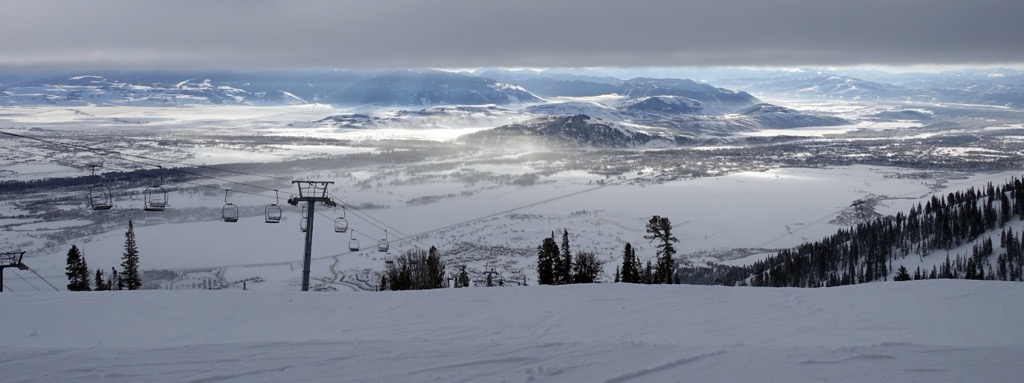
Jackson Hole is undoubtedly a geographically ideal location for a big mountain ski resort. First, the vertical orientation of the Teton Range efficiently captures moisture from a predominantly west-to-east flow of weather. The narrow character of the Tetons means the skiable terrain stretches from the range's crest to the valley floor, hence the massive vertical drop.
However, the Tetons are the only range in the Rocky Mountains that receive truly coastal amounts of moisture. The secret is a geographically low-lying moisture channel comprising two main features: a break in the coast range between Mount Shasta (14,176 ft / 4,321 m) and the rest of the Cascade Range, and the Snake River Valley in Idaho. Storms funnel their way up this valley and collide with the Tetons. The range's vertical orientation and massive prominence cause moist air to rise and condense into precipitation that falls as snow.
Big storms regularly buffet this region. The Tetons are known for high winds, low visibility, and frostbite-inducing temperatures. When the storms finally break, the weather can be stunning. Low humidity, abundant sunshine, and perfectly crisp temperatures can make for memorable skiing.
Naturally, there are also some disadvantages regarding JHMR’s location:
The Tetons are a mecca for skiing, and it’s possible to make turns in the backcountry for most of the year. However, Jackson Hole Resort is generally open from Thanksgiving to the first or second Sunday of April each season. For example, in the 2022–2023 season, at the time of publication of the guide, it is November 25th — April 9th. However, not all parts of the season are created equally.
The first month of the season — Thanksgiving to Christmas — will likely feature more limited terrain options compared to later, after the snow has had a chance to stack up. That said, the early season can feature significant lodging, parking, or lift pass discounts (think Liftopia). It will also be easier to find availability. The resort will be relatively uncrowded compared to Christmas, President’s Day Weekend, MLK Weekend, and Spring Break. Moreover, JHMR gets a ton of snow, and conditions can be epic by mid-December.
JHMR gets crowded because it’s very much on the radar as a fantastic destination for both free-riders and well-heeled clientele. I must be honest — sometimes, lines at the Tram can be hours long, even on non-powder days. Jackson Hole Resort is still incredible. But if you have a flexible schedule, want to avoid lines, and still have a chance at some great skiing, I highly recommend checking out early-season deals.
Peak Season at Jackson Hole Mountain Resort is Christmas and the New Year, President’s Day Weekend, and MLK Weekend. Generally, these are the busiest days at Jackson and the busiest days to ski in the US. I love JHMR but don’t recommend skiing at the resort these weekends.
In recent years, JHMR has fallen victim to its reputation as the fiercest freeriding in the country and its inclusion on the Ikon Pass. The accessibility provided by the Ikon Pass has drastically increased skier visits, especially during holiday weekends. The resort has excellent lift infrastructure, but with only 13 lifts, the mountain can become overwhelmed. Long wait times, crowded slopes, and unhappy patrons are the result.
Fortunately, if you take a ski vacation at Jackson Hole Ski Area anytime besides Peak Season, you can find walk-on lifts and uncrowded slopes.
February, March, and early April are characterized by winter conditions during storms, while warm sunny days fill the gaps. In my experience, the snow can deteriorate fast once the sun comes out, especially later in March. You can start the morning with beautiful powder skiing and sweat your way down knee-twisting mashed potatoes by mid-day. You can also have days on end of snow, wind, and general mid-winter conditions.
The best spring skiing I have ever done was at JHMR during a couple of weeks of high pressure in March 2017. There was a huge base, and the snow was consistently soft throughout the upper mountain. Everybody was having a great time, making pretty turns, and wearing short sleeves in the sunshine. These days are almost better than powder days because you don’t feel like you have to compete.
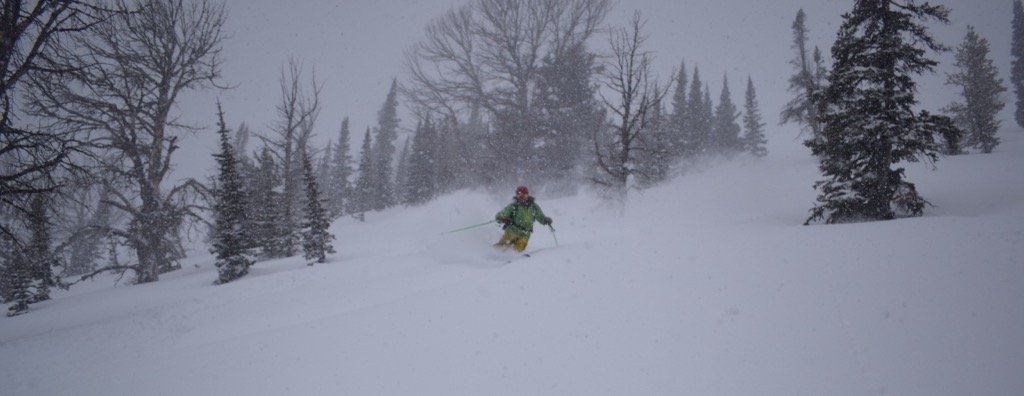
January is often the best time to ski at Jackson Hole Mountain Resort. They call it “Japan-uary”, but it’s actually “Jackson-uary”. January is, statistically speaking, the snowiest month. Often it can snow for weeks without pause.
We have already attributed this abundant precipitation to our friendly neighborhood “moisture channel,” funneling in the good stuff on express delivery from the Pacific Ocean. The western US receives a lot of snow, and this precipitation can fall from October to May. Any time of the season can be snowy in the Tetons, but in January, you have the statistically highest chance of receiving fresh snow on your trip.
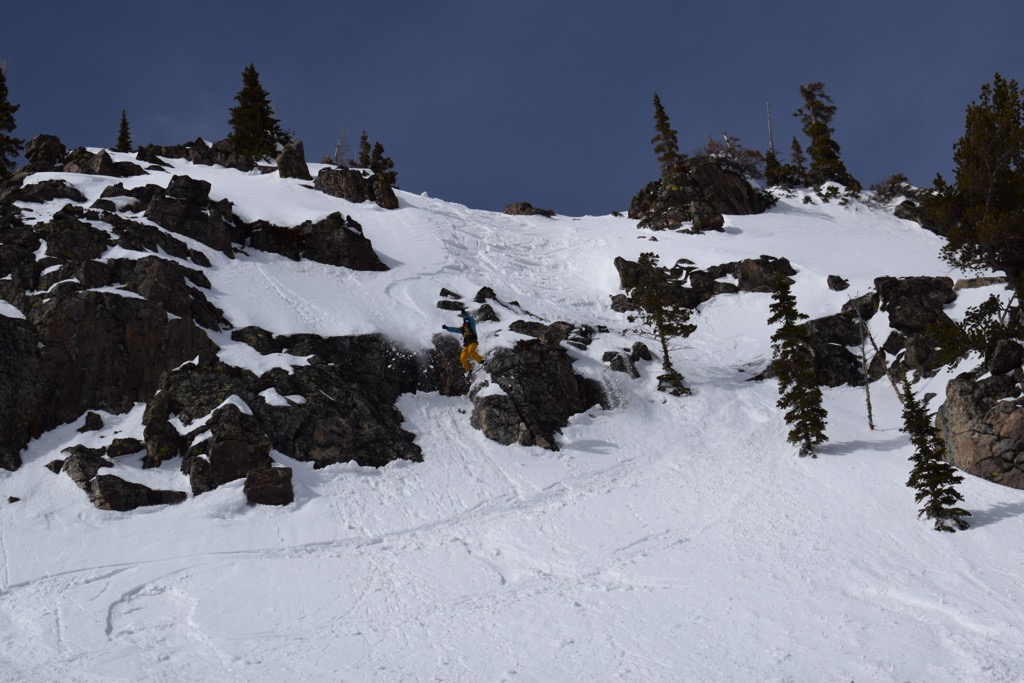
January is tremendous for a few other reasons as well:
But we live in a competitive world and skiing is no exception. While Jackson’s notorious storm days once kept the frothing crowds at bay, they now throng the gates begging for more. We can attribute the change of attitude to the advent of better gear — fat skis, rigid plastic boots, and gore-tex jackets, to name just a few of our new gadgets. It’s a blessing and a curse. Each of us can ski with more prowess than before, but it also means that the challenging terrain is accessible to more people.
So one way to rise above the competition is to make time for skiing when others are occupied. January is a tough time for tourists to get away — it’s so soon after the Holidays that many folks cannot take time off. The slopes are relatively empty.
On the other hand, I recognize that only some folks are ambitious powder skiers. Those who prefer fair weather have reason to avoid Jackson in January. The probability of bluebird days is low. The sun is meager and does not radiate warmth. January can often feature brutally cold temperatures in Jackson Hole because cold, dense air sinks into the valley at night. Even if it’s warmer at the top of the mountain, this can make for difficult ski conditions, especially for folks looking to cruise groomers in the sun.
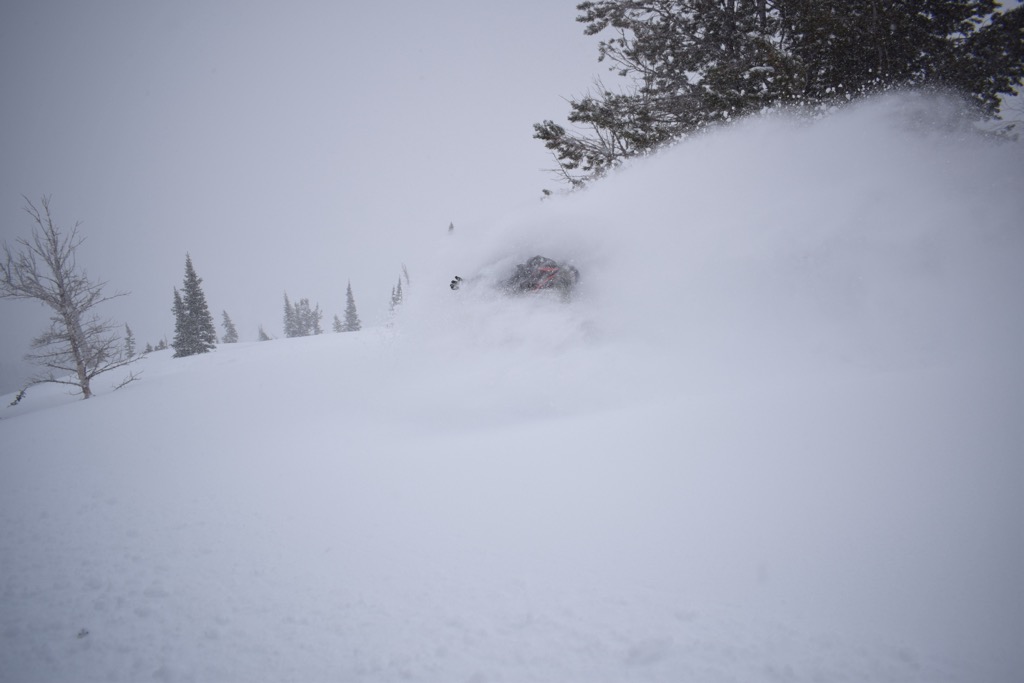
Jackson Hole Mountain Resort, while the largest in Wyoming, is relatively small compared to others in the US and the world. These are some of the mountain’s named features.
As a general rule, the lookers’ right (east) of the mountain is beginner and intermediate-friendly, while the lookers’ left (west) caters to advanced and expert skiers.
The Jackson Hole Map is easy to understand, and you will figure out the basics of the lift system in one day. The layout of the lifts makes it extremely easy to get from one part of the mountain to another. There is only one base area and very little traversing. However, it will take years to explore the intricacies of all the terrain packed in between!
JHMR has 13 ski lifts. There are nine quad chairlifts, two gondolas, one double chairlift, and one cable car. The resort reports a lift capacity of over 22,000 skiers per hour.
The lift infrastructure will run even more smoothly now that the Thunder triple has been replaced with a high-speed quad - this was a significant bottleneck for skiers trying to get to the upper mountain. The resort also upgraded the Teton Lift within the last ten years. Most of the lifts are now high-speed and detachable. The Sublette and Marmotte are the only slower fixed-grip chairlifts left on the upper mountain.
The main attraction at JHMR is backcountry skiing rather than the groomers. The grooming could be more consistent compared to other resorts. Much of the rest of the mountain is ungroomed or off-piste. Check the grooming report here to get beta on the fresh corduroy because it changes daily.
The Tetons mountains are great for tree skiing because of the widely spaced trees at all elevations. The open space gives the terrain an alpine feel, while the trees give depth perception and provide excellent visibility, even on stormy days.
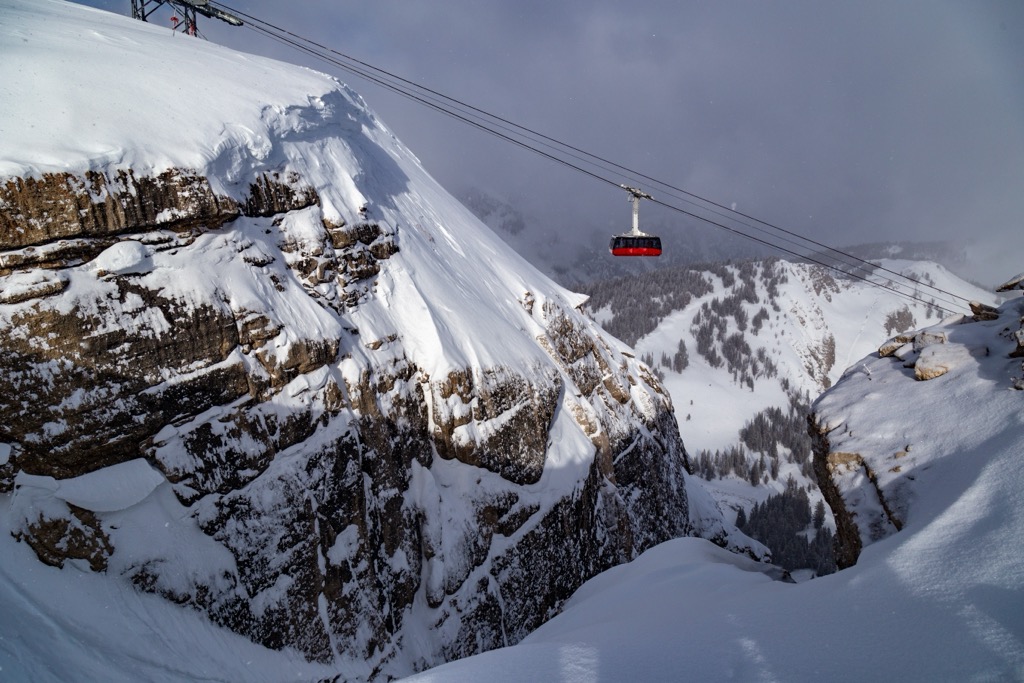
The Eagles Rest Chair is for absolute beginners. These are short, flat runs for those just learning how to ski. Teewinot is next on the progression. Jackson is steep, but Eagle’s Rest and Teewinot take advantage of a flat shelf above the valley to provide excellent skiing for beginners. Teewinot is slightly longer and more committing than Eagles Rest, but the terrain is similar overall. The Sweetwater Gondola also has a mid-station serving the same terrain as Eagle’s Rest for those who want the comfort of a gondola on the ride up.
After Teewinot, skiers can advance to the Sweetwater Gondola and the Casper and Apres Vous chairs. The Bridger Gondola also offers some intermediate terrain, but it is long and may be difficult for skiers still building their strength. The Sweetwater and Bridger gondolas are great for the family on cold stormy days because they provide protection from the elements and have plenty of intermediate terrain on tap.
The Tram is the only lift at JHMR that is truly expert-only. Other chairs have access roads and cat tracks that a beginner skier could slide down if they somehow ended up in the wrong place.
Once a skier heads down Rendezvous Mountain, there is no choice but to finish the descent. On a bluebird day in the right snow conditions, Rendezvous Bowl skies like an intermediate piste. However, the conditions up here are often so gnarly that only expert skiers should ride down. If you’re a beginner and want to visit Corbet’s Cabin, you can take the Tram up and down roundtrip.
The Tram is not only a JHMR staple but one of the most iconic ski lifts in the world. Check out this brand-new video from JHMR on the operation of the Tram. Kudos to the guys and gals that keep this beast running. This mini-doc is some of the best content I’ve seen coming out of a ski resort, and it does justice to the magnitude of this machine.
The Tram stops at nothing to get you to the goods. 4.3 Miles / 6.92 km, 4139 ft / 1261 m vertical, 9 minutes to the top, and the Tram will get you there in winds up to 70 mph / 112.6 kph.
Marmotte, Thunder, Sublette, and Teton are great lifts for advanced and expert skiers who want to experience the upper mountain.
The Moran Face off the Teton lift has excellent terrain and is easy to lap repeatedly. Few people are here, but the area is South-facing, and the snow quickly becomes heavy.
Off the Apres Vous chairlift, Saratoga Bowl offers good tree skiing and holds stashes of good snow long after a storm. Pick your way around back here, and you’ll reap the rewards. This side of the mountain is often less crowded on powder days because skiers gravitate toward the Tram side (lookers’ left).
The Hobacks are legendary. They hold good snow because it’s hard to access them. You have to take the Tram or the combination of Bridger - Thunder - Sublette. The small egress leading to the Hobacks can be easy to miss - it’s on your right where the Rendezvous Trail starts sweeping to the left. It’s tight initially but opens up into an expanse of fall-line powder skiing.
Everything off of Thunder and Sublette is fun for advanced to expert skiers. The terrain is playful, with plenty of steep shots, cliffs, trees, and bowls. It’s also a big attraction on powder days.
Rendezvous Bowl can offer many folks their first experience of sublime, alpine powder skiing. This Bowl collects even more snow than the rest of the resort, so the turns here can be deep when the base area has only a dusting.
Then there are the Backcountry Gates, which effectively triple the size of the ski resort.
JHMR experienced an identity crisis in 2019 when the resort management joined the multi-resort Ikon Pass. That season, the resort became overrun with skiers. Lines were out of control, and photos started circulating online showing lift lines that looked more like the crowd at Woodstock.
Some clients paid tens of thousands of dollars for vacation and only got a few runs a day. After holding the number 1 spot for years during the 2000s, JHMR’s rating slipped on many ski resort ranking sites.
The debacle prompted locals to start a petition to back out of the Ikon deal. It wasn’t just crabby locals exercising their right to complain. The situation affected the quality of Jackson’s legendary product for tourists and old-timers alike.
Although they didn’t terminate the contract with Ikon, the JHMR management made changes. They restricted the number of skiers per day on multi-resort passes, chopped sales of day passes at the ticket office, and implemented a reservation system.
Lift lines at JHMR have improved significantly since the changes. The line at the Tram is still long because cable cars don’t have a lot of skier capacity and because the Tram is one of the best in the world. There is unlikely to be a significant line at the other lifts unless it is Peak Season or a big powder day.
JHMR has some of the best ski resort slopes in the country. Check out the JHMR ski resort map here. With quick access to so much enjoyable terrain, it’s easy to rack up the vertical on massive thigh-burning descents. Skiers of all levels will challenge themselves and improve their technique at JHMR. Here’s a quick breakdown of the mountain statistics at JHMR:
Slopes
Ski lifts
Other skiing-related features
Backcountry skiing is the name of the game in Jackson Hole. Many pro skiers choose to live here because of the ethos of personal responsibility and access to the mountains.
The Backcountry Gates at the resort provide lift access to some unbelievable lines (and unbelievably dangerous).
Grand Teton National Park offers backcountry touring in a stunning National Park setting, where you can find solitude in nature.
Teton Pass is easy-access roadside touring, where you can quickly tag fun lines before or after work.
The JHMR Access Gates offer some of the most incredible lift-access backcountry skiing in the US. Although many other resorts have jumped on the bandwagon, they were the first of their kind in America.
The saga of these access gates is one of the great tales in skiing. For decades, the backcountry surrounding the resort was closed to skiers. However, an exclusive and rogue group of skiers called the “Jackson Hole Air Force” was sneakily “poaching” the terrain because the conditions were so good.
Eventually, the contest between JHMR Ski Patrol and the Air Force came to a head, and some renowned local skiers were banned from the resort. A few years later, the resort, in conjunction with the forest service, finally opened the Gates. The film “Swift, Silent, Deep” documents this mythology and is worth watching if you’re interested in JHMR (or skiing in general).
Nowadays, the Gates are more like an extension of the ski resort. You will be seeing other tracks and the folks who made them. But it’s still my favorite thing about the Jackson Hole.
It’s also still perilous, especially Granite Canyon. “If You Don’t Know, Don’t Go” is the slogan you will become accustomed to hearing at the top of every Tram ride. JHMR offers an in-house guide service for clients who wish to explore this terrain safely. If you’re a knowledgeable backcountry skier, I recommend going with a partner who knows the routes, at a minimum. Check out the “Jackson Hole Ski Atlas” for the visual beta.
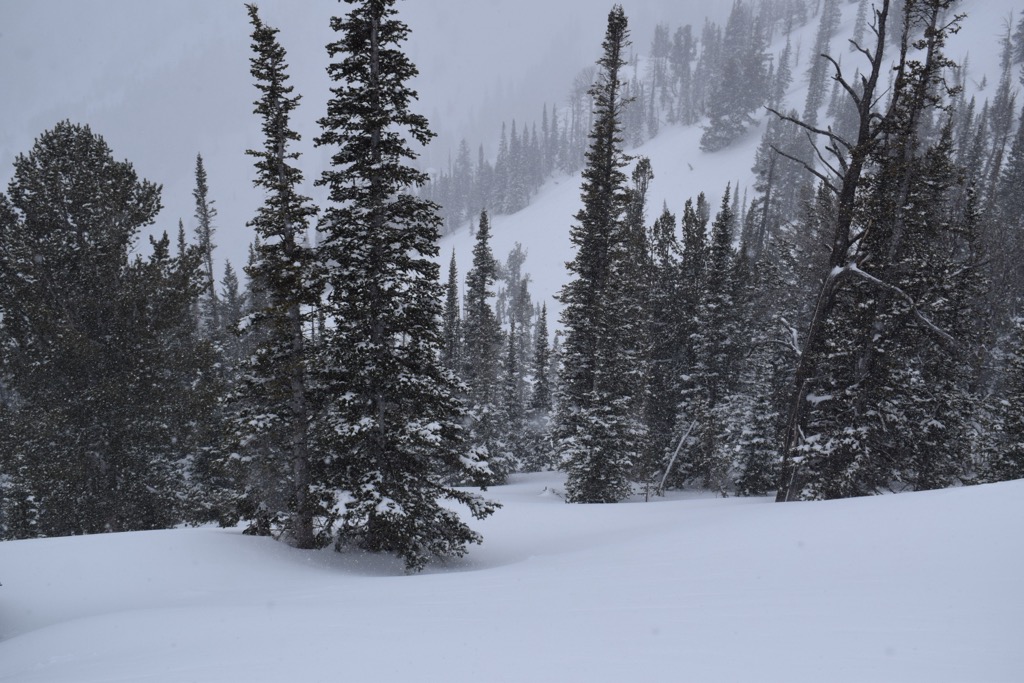
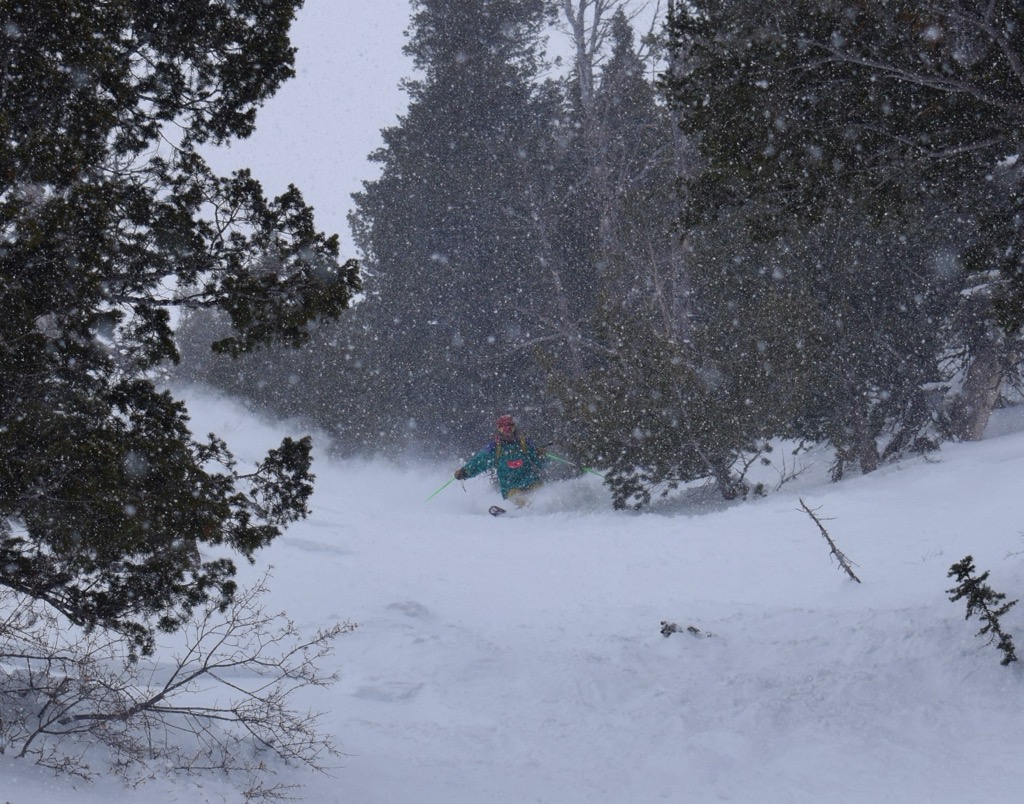
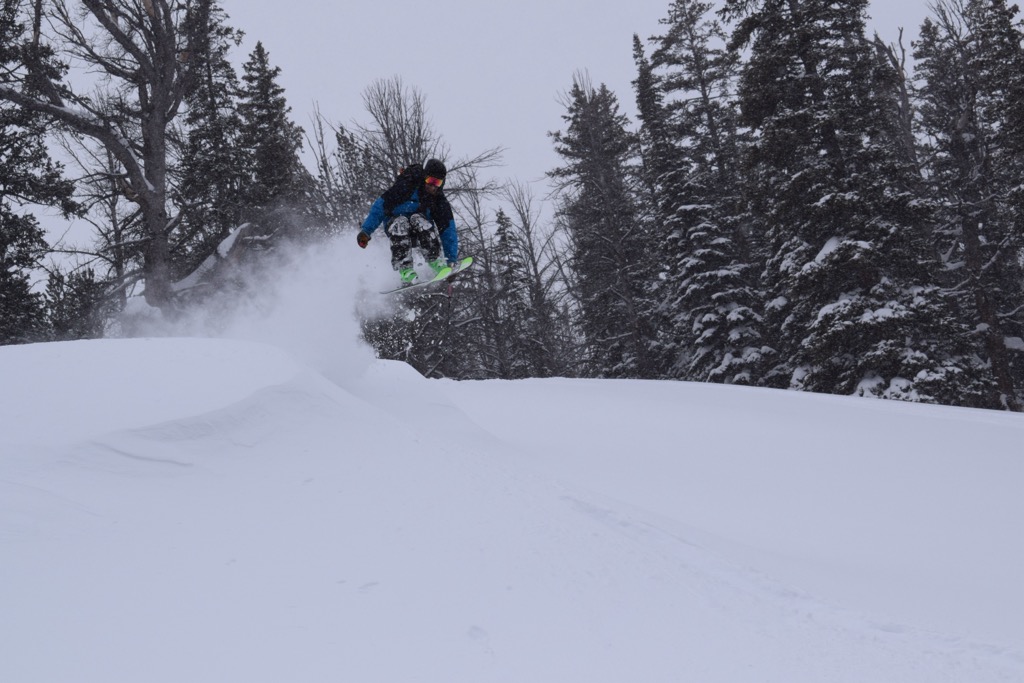
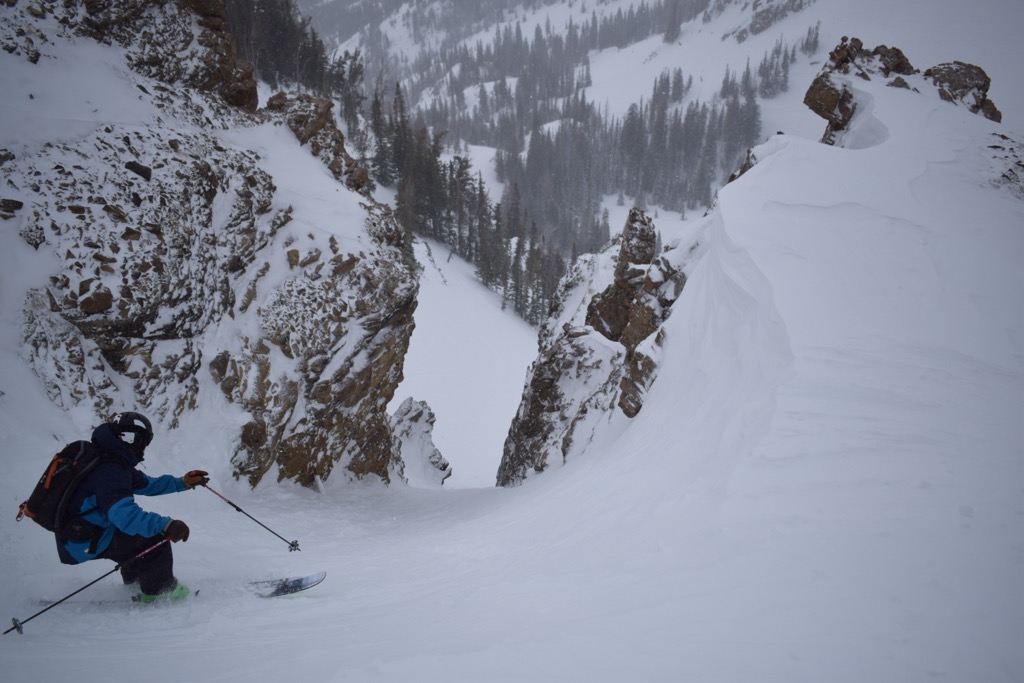
The best backcountry skiing around Jackson is within the boundaries of Grand Teton National Park. The park and the skiing experience are just extraordinary. The famous big routes, like the Grand, are in the park. However, for first-timers, I recommend starting with a beautiful route called “25 Short,” named after the summit, which is 9,975 ft (3,040 m) — 25 ft (7.2 m) short of 10,000 ft (3,048 m).
The routes back here are far more committing than the resort gate access. Even 25 Short, which is by far the easiest route, is a 3,300 ft (1,005 m) climb with a descent through significant avalanche terrain. There is an abundance of mountain guide services operating within the region. The most famous is Exum. Hire a guide if you don’t know the ropes.

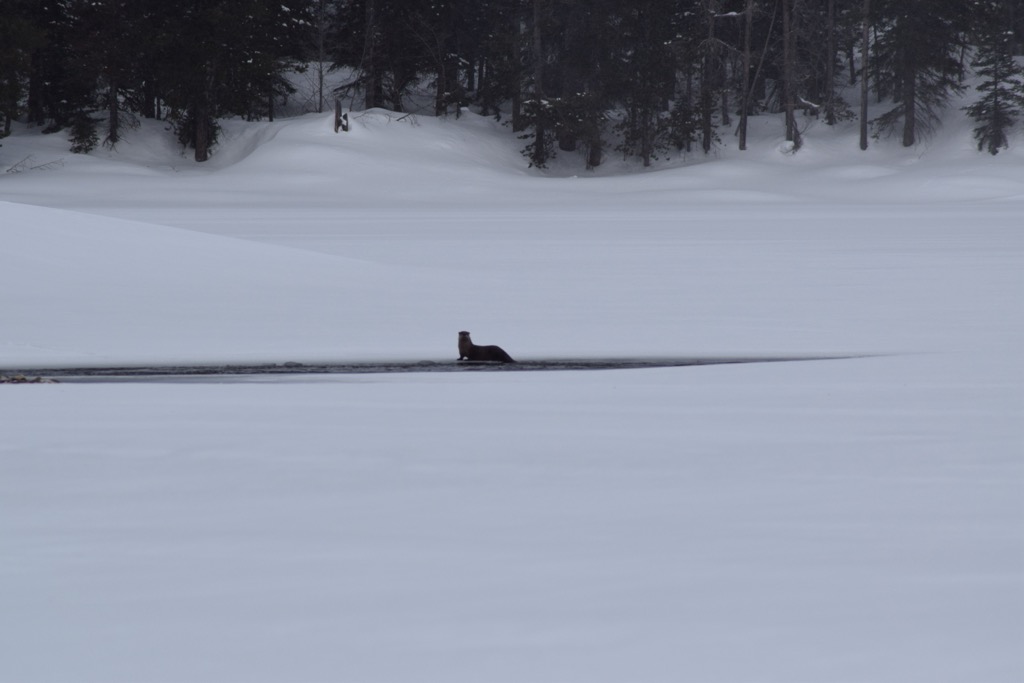
Teton Pass is the most popular backcountry zone in the area around Jackson. Sometimes it seems more people are at the pass than at the resort. It’s easy to understand what all the fuss is about once you experience the quality of the terrain and access efficiency.
In just an hour, you can bootpack up past the billboard (north side of the road) to Glory Mountain (10,032 ft / 3,058 m) and ski down 2,000 vertical ft (610 m), hitchhiking or shuttling your way back to the top. Watch out for other people, though — one issue with the pass is that folks will be skiing on top of each other. There are also a lot of beginners, and this exacerbates the problem. But beginners have to start somewhere, and Teton Pass is as good a place as any.
If you want to strap on the skins, Taylor Mountain (10,341 ft / 3,152 ft) is my favorite proper ski tour on the pass. It’s much less crowded than Glory but also more of a commitment. All these routes are in the Jackson Hole Ski Atlas mentioned above.

Ski passes at Jackson Hole Mountain Resort are undeniably expensive. Moreover, they can sell out on very popular days so be sure to book in advance.
The price of a day ticket at the window varies depending on the day, but it is over $200. On peak season days, it can run as high as $230. Luckily, there are at least two ways to avoid paying full price:
The best option for tourists is to buy either the Ikon Pass or the Mountain Collective Pass:
If you only use your days at JHMR and no days at other resorts, the Ikon offers little savings over buying day passes. However, the Ikon Pass is an incredible deal because you can access over 50 resorts across North America. Even if you use all of your days at JHMR, you can still visit many of the best ski resorts on the continent.
More than a dozen resorts have unlimited access — the Ikon Pass is their season pass. Ikon Pass holders receive other benefits, including a 25% family and friends discount on day passes and a discount on food, lodging, and retail (varies depending on the location).
All multi-resort pass holders are subject to the new reservation system that Jackson has implemented to limit overcrowding, especially on weekends, holidays, and big powder days. All Mountain Collective and Ikon Pass holders are required to reserve their visit in advance.
The glory days of rolling up on a powder day with a multi-resort pass are over. However, the JHMR lift infrastructure was buckling from the increased traffic, and the reservation system will help alleviate some of the strain. Guests will have a better resort experience. Reservations can sell out, so reserve early.
You can always change your reservation, and there is no fee for canceling. If you’re not going to show up, please cancel your reservation by 11 a.m. the day of so that somebody else can have the opportunity to ski.
Make Ikon Pass reservations by going to “My Account” at Ikonpass.com. Mountain Collective reservations are made on the JHMR official website.
As with most resorts, many different services are available for skiers at Jackson Hole, including outdoor stores, equipment rentals, and many others. JHMR runs a ski school with various programs for adults and children to improve their mountain skills, such as private and group lessons and camps. Jackson Hole’s private instructors are PSIA Level III Certified. You can also find backcountry guides at the resort.
The Visitors Center is a state-of-the-art facility that will point you in the right direction on any topic. Here’s the main one in Jackson:
Jackson Hole & Greater Yellowstone Visitor Center
532 North Cache Street (next to the Elk Refuge), Jackson, Wyoming, 83001, USA
Daily from 9 am to 5 pm
There are nearly 100 restaurants in the whole valley if you count them all. Jackson is big enough to get any fast food you want or an expensive fine-dining excursion. A quick search on the Internet will find what you're looking for, but here are a few of my favorite spots around town.
Many folks choose to stay in Teton Village over Jackson. There are a plethora of options, from condos to luxury hotels. It is a good choice for individuals and families looking for the ski-in-ski-out experience. The accommodation here is more expensive, but avoiding the hassle of commuting each day is worth the extra money for many people.
However, one killer deal remains for serious skiers looking to stay in Teton Village. Known simply as The Hostel, this legendary locale has been the temporary home to hundreds of thousands of skiers since it opened several decades ago. You won’t be disappointed, but book early because these rooms sell out fast.
The main reasons to stay in Jackson are the following:
As crowded as this place is in the winter, it’s busier in the summer. The hotel and resort infrastructure was built to accommodate the summer crowds (all five million of them) who visit the Teton National Park. Therefore, a surplus of winter beds keeps prices down slightly.
The only disadvantage of staying in Jackson is that you must commute to the resort each day you want to go skiing.
You may have had the best powder day of your life. Or perhaps you have taken a spill, tweaked your knee, and ended your vacation. Either way, good times are waiting for you after the lifts close. Whether celebrating those soft turns or trying to mask the soreness — often simultaneous occurrences in Jackson — you will not be disappointed with the Après-ski options around here. There are dozens of spots to grab a pint throughout the valley, but these are my two favorites:
The Mangy Moose at Teton Village base areas pops off Austria-style after any given day. The Moose place is loud and packed, with a great vibe. Just take your skis off out front and stomp right in — the floor is tattooed with a patina that only decades of ski boots and beer can produce. It’s the spot if you want to meet friends and share tall tales about your day of skiing.
Don’t expect fast service or great food. The place is usually mobbed, and it might take a second to get everyone's order in. The fare is the usual greasy bar food, but hey, it hits the spot after a big day on the mountain. When you stumble out the door several hours later, still in your ski boots, you’re guaranteed to have a smile on your face.
Sometimes local musicians jam out in the afternoon, but the Moose also puts on big concerts. These always happen at night.
The Stagecoach is located right at the base of Teton Pass in the hamlet of Wilson. This place was founded in 1942 and is a little taste of the old cowboy Jackson that has slowly faded over the years. Before all the ranches got sold off to developers, cowboys and girls rode their horses right through the front door.
The food and drinks here are reasonably priced, and you can always get into a great game of pool. They still operate a drive-through liquor store in the back, too. The management seems pretty chill — they didn’t seem to have any problem with me sleeping in my van a few times in the back parking lot. They have some big dance parties that go late and get the house packed with young people.
As long as the Stagecoach is still in business, there will always be that little part of Jackson that still caters to the humble ski bum.
Like all the best ski towns, Jackson has a sick music scene. There are usually about a dozen top-tier bands every winter. I already mentioned the Mangy Moose, but the Center for the Arts also has several concerts every season. They also feature other events like film showings and avalanche awareness programs.
A large Aquatic Center in Downtown Jackson has a pool, sauna, jacuzzi, steam room, gym, basketball court, and waterslide. It’s a great place to check out if you have kids or want to recover after a big day on the slopes.
Don’t forget the movie theater, Movieworks Cinema 4, and bowling alley in Downtown Jackson if you want to spend a chill day inside.
Snow King is the baby sibling of JHMR, located right on the edge of Downtown Jackson. Locals often refer to it as “Town Hill.” It’s not the best ski area, and you may not want to visit it during your trip to Jackson, especially if you’re only in town for a few days. But some great things about this small ski area are worth noting.
The King is steep. It’s got a gritty, local vibe that is precisely the opposite of Jackson. Many ski racers in Jackson train at Snow King, so you’ll always see gates set up and young athletes shooting for the stars. It’s also popular with locals who want to take a quick backcountry ski in the morning - sort of like the ski touring equivalent of going for a jog.
There is some fun terrain when the conditions allow. The best time to ski at Snow King is during a big storm when JHMR is closed due to avalanche danger. Sometimes you can find great skiing with no crowds. Another “Snow King scenario” is when there is a bluebird powder day at Jackson on a weekend or during Peak Season. Check the snow report. Consider a sojourn to the King, even if they get less snow. It’s better than waiting in line all day.
The King is also notoriously icy. The conditions are often similar to what you would find at an East Coast resort because they don’t get much snow. The whole area is in the precipitation shadow of the Teton range.
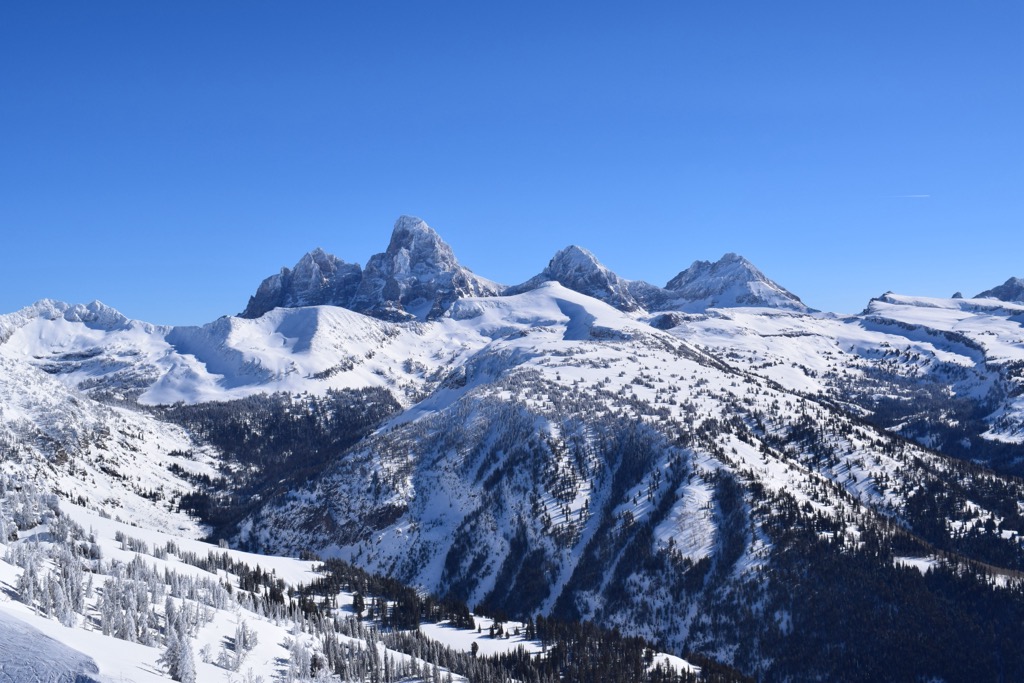
Generally speaking, Targhee is under the same weather system as JHMR. They average a bit more snow because they are located on the west side of the Tetons, facing the main flow of weather. The windward exposure also means that Targhee is subject to heavy cloud cover; locals have endearingly nicknamed it Grand Foggy.
Northwest Flow is The thing to watch for at Grand Targhee. It’s a weather pattern that will set up, on average, a few times every season. This wind direction is more favorable for heavy snow at Targhee. They have been known to wake up to 30 in / 75 cm of powder when JHMR has much less. Northwest Flow is conducive to stellar dendrite snowflakes, so the snow is more likely to be blower powder.











